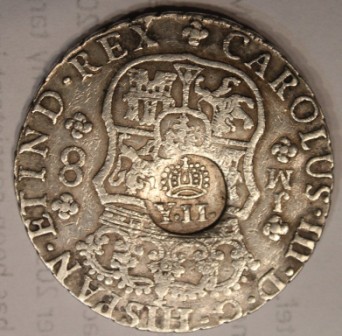filipinonumismatist
Admin

Posts : 275
Points : 83207
Reputation : 14
Join date : 2009-02-20
 |  Subject: Guide on Buying Philippine Counterstamp coins Subject: Guide on Buying Philippine Counterstamp coins  Wed Feb 19, 2014 10:31 pm Wed Feb 19, 2014 10:31 pm | |
| I am getting numerous inquiries lately on how to determine the authenticity of Philippine counterstamp coins. Though there is no specific guide that i can give an avid collector on what specific counterstamped coins are genuine or not, but I will give some simple tips on how to determine authenticity using some fundamentals.
First, counterstamped YII and F70 coins were issued only between 1828 to 1835. F70 from 1828 to 1832 (33) and YII from 1834 to 1835. Logically, there should be no F70 counterstamps on coins dating beyond 1833 for F70, and otherwise no YII counterstamps coins dating beyond 1835. If ever you see a coin which has a date beyond bearing counterstamp, they are fake: Second, a counterstamp should otherwise be uniformly oval or circle. Superficial or partial counterstamp is an indication that the coin might have been stamped manually using a duplicated die and by hand and a hammer which caused such unevenly strike. Genuine counterstamp coins undergone several processes such as annealing and machine press which is why the depth of the strike and the size of the stamp can be measured uniformly from one coin to another. Below is an example of modern day crude strike using a duplicated "counterstamp" die. If you happen to see a similar specimen, be suspicious. Second, a counterstamp should otherwise be uniformly oval or circle. Superficial or partial counterstamp is an indication that the coin might have been stamped manually using a duplicated die and by hand and a hammer which caused such unevenly strike. Genuine counterstamp coins undergone several processes such as annealing and machine press which is why the depth of the strike and the size of the stamp can be measured uniformly from one coin to another. Below is an example of modern day crude strike using a duplicated "counterstamp" die. If you happen to see a similar specimen, be suspicious. Third, some modern day counterstamp coins seem produced together with the coin or casting for short. These are the kind of fake counterstamp coins lurking in the market right now. Like this one below: Third, some modern day counterstamp coins seem produced together with the coin or casting for short. These are the kind of fake counterstamp coins lurking in the market right now. Like this one below:
 Fourth, most counterstamp coins are in very poor state so do not expect that a counterstamp coin should turn into an almost uncirculated coins. Remember, counterstamping is a form of revalidation so most candidate coins were circulated and dilapidated coins. Below is a modern day fake counterstamp coin: Fourth, most counterstamp coins are in very poor state so do not expect that a counterstamp coin should turn into an almost uncirculated coins. Remember, counterstamping is a form of revalidation so most candidate coins were circulated and dilapidated coins. Below is a modern day fake counterstamp coin:
 Fifth, do some research and be observant. Determining authenticity is not rocket science. A simple physical analysis and common sense are sufficient to save you from collecting disasters. Since counterstamps on coins are much recent than their host coins, counterstamps should either appear more visible than their host or as equal as their host coins. Apparently, the specimen below appears to be the opposite: Fifth, do some research and be observant. Determining authenticity is not rocket science. A simple physical analysis and common sense are sufficient to save you from collecting disasters. Since counterstamps on coins are much recent than their host coins, counterstamps should either appear more visible than their host or as equal as their host coins. Apparently, the specimen below appears to be the opposite:
 HOPE THIS HELPS. HAPPY HUNTING! HOPE THIS HELPS. HAPPY HUNTING! | |
|
